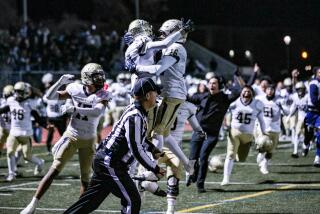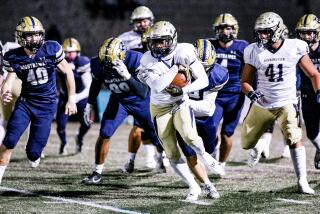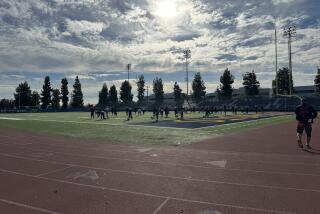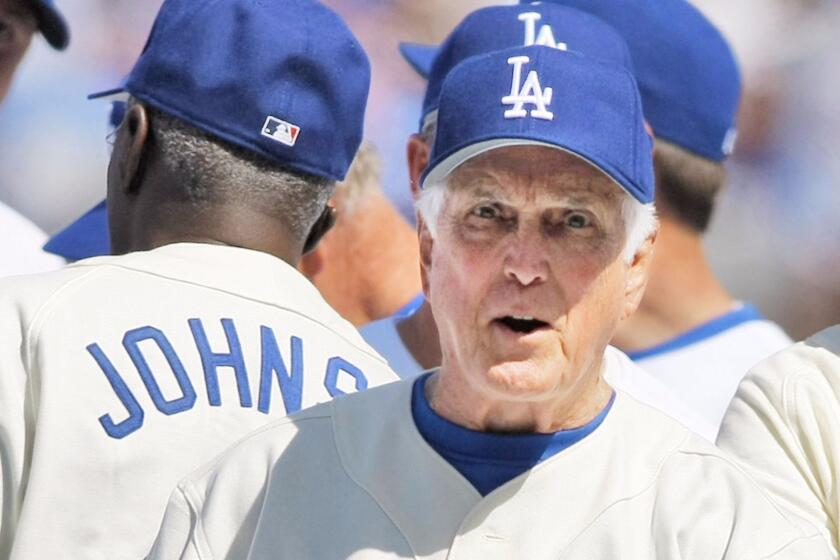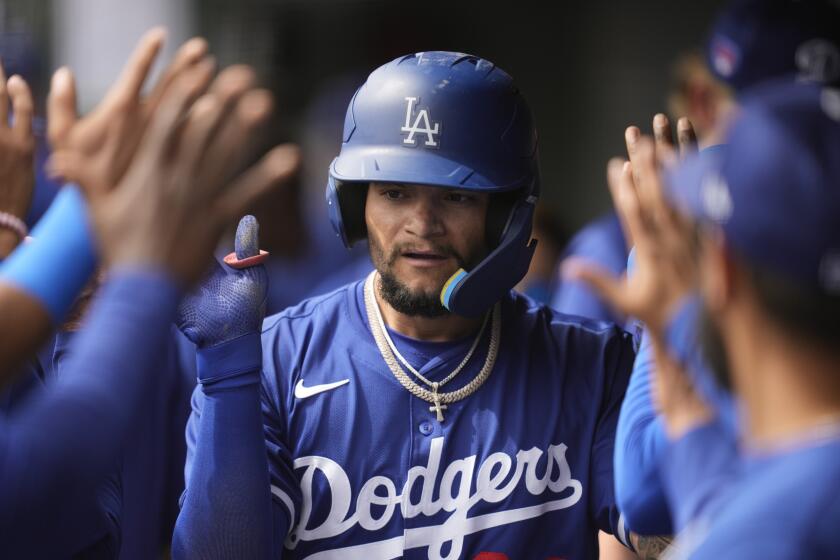From Fumblerooskis to Flea-Flickers
Gene Uebelhardt may or may not recall the exact beverage that prompted him to scrawl his masterpiece on a bar napkin at Sam’s Saloon in Oxnard — “I’m sure it was a Diet Pepsi that brought it out,” he recently quipped — but the resulting play remains forever etched in his mind.
It was a trick play, a double pass that the budding college assistant later showed to his boss at Cal Lutheran, Coach Bob Shoup. The Kingsmen, who play at the NCAA Division III level, gave the play a try during a 1978 game against Cal Poly San Luis Obispo and it went for a long touchdown.
Twenty-five years later, Uebelhardt, now the coach at Simi Valley Royal, is still a leading proponent of the trick play.
And he’s not alone. Scores of high school coaches across the Southland view gadget plays, ranging from flea-flickers to double reverses, as effective and surprisingly easy ways to outmaneuver the opposition for a long gain or a quick score.
“When they work, it means you’ve found some way to trick your opponent,” said Uebelhardt, 51. “It’s not like you’ve overpowered someone. It’s just strategy.”
Coaches say trick plays are low-risk, high-reward propositions that rely on deception and timing. Irvine offensive coordinator Tom Ricci called a double pass on the first play from scrimmage in a recent game against Laguna Hills. The play went for a 65-yard touchdown as the Vaqueros seized the early momentum en route to a 17-0 victory.
“Who knows how the game would have turned out if we hadn’t pulled that play then?” Ricci said. “It put the kids in a better frame of mind against a tremendous defense.”
Coaches caution that trick plays are not a universal remedy for vaunted defenses. Westlake Village Oaks Christian Coach Bill Redell recalls running one of his trademark fumblerooski plays against Sherman Oaks Notre Dame, which he considered a five-touchdown favorite.
“It went for a touchdown,” Redell said of the play, “and we still lost by five touchdowns. But it made it entertaining.”
That is perhaps the most underrated aspect of the trick play.
“It creates fun and excitement with the players, even in practice,” Venice Coach Angelo Gasca said. “Even if they’re not successful, they help keep things loose.”
Gasca said he implements trick plays that accentuate the strengths of his offense, including a wide receiver option pass that allows one of his multitalented skill players to throw the ball. The Gondoliers used three trick plays earlier this season during a 17-13 victory over Los Angeles Loyola.
“We’re trying to hit a home run every time we use them,” Gasca said.
Thousand Oaks Coach Mike Sanders used the fumblerooski twice this season against Camarillo, watching in glee as guard Jesse Border rambled for touchdowns on each attempt.
The play involves placing the ball on the ground just behind the center after the snap while the offensive backfield creates a diversion by running toward one side of the field. An offensive lineman then scoops up the ball and heads in the opposite direction.
The fumblerooski is so effective, Redell contends, “I’ve had guards that you could time with an hourglass, and they’ve still scored.”
The 62-year-old Redell, considered the dean of the play by many Southland coaches, estimates he has run it 30 times over the last 10 seasons, resulting in 20 touchdowns and only one fumble.
“It’s a low-risk play,” said Sanders, who learned how to execute the fumblerooski as an assistant under Redell at La Canada St. Francis. “If it doesn’t work out, you just have the guard smother it.”
Said Redell: “When it works, it looks great. And when it doesn’t, you try to blame an assistant.”
The key to executing trick plays is timing. Like a pitcher unfurling a rainbow-arcing ephus pitch on a 3-2 count, the element of surprise can make all the difference, leaving tar-heeled defenders clueless as to where they need to position themselves as the play unfolds.
Venice’s Gasca prefers to use gadget plays after turnovers or a stop on downs. Irvine’s Ricci opts for them when his offense is approaching the red zone.
And then there’s Mission Viejo offensive coordinator Bret Johnson, known to utilize trick plays on any given down. The Diablos twice scored touchdowns on double-reverse passes during a dramatic victory over Long Beach Poly, prompting Mission Viejo Coach Bob Johnson, Bret’s father, to predict that the play might be retired for the season.
“Once you’ve used them once or twice,” Bob Johnson said, “you better shelve them for a while and come out with new ones. People scout and work on the things you’ve done with success.”
Gasca said his team repeats the plays “if they complement your offense.”
“If you run the reverse with regularity — and we run two or three every game — why couldn’t you run the reverse pass every week?,” he said. “Everyone scouts you, but they don’t know when the special plays are coming.”
That’s not always the case, it turns out. Since quarterbacks are often known to alert game officials before running a fumblerooski, some coaches assign players to monitor the quarterback’s every move between plays. The only drawback is that opposing coaches can counter by having an alternate player notify the officials.
The only thing tricky about trick plays might be defending them. They require little practice time and are easier to execute than one might imagine.
Thousand Oaks’ Sanders said the fumblerooski doesn’t take up much practice time since the blocking schemes are similar to what his team already runs. Gasca said his team needed only two minutes to practice a reverse pass it used for a 70-yard touchdown the following day in a victory over Granada Hills.
Undefeated Riverside North became so adept at trick plays that it used two during a four-game streak of scoring on the first play from scrimmage, though one play was called back by penalty.
The Huskies capitalized on a reverse pass against Moreno Valley Rancho Verde and a hook-and-ladder play against Rialto Eisenhower.
The streak ended when a double pass failed against Alta Loma. Double passes work when the secondary converges on a receiver or running back who has caught a pass behind the line of scrimmage, only to watch that player throw to a usually wide open receiver downfield.
“We wanted to put some pressure on the other team right away,” reasoned Riverside North Coach Lou Randall.
No matter how innovative these coaches may seem, most concede that the credit lies elsewhere. Many ideas were gleaned at clinics, through conversations with other coaches or by simple imitation.
“Every good idea in football has been stolen at least twice,” said Sanders. “Everything I have, I stole from somebody.”
Redell said he initially saw former Nebraska coach Tom Osborne employ the fumblerooski early in his career and then watched Oregon State use it against Stanford shortly before it was outlawed at the college level.
Only then did Redell start experimenting with it.
Gasca said there were plays he thought he invented only to watch another coach use them on television.
Perhaps Uebelhardt, who diagramed the double pass on the bar napkin, is an original when it comes to diagraming trick plays, but even he won’t take full credit.
“I don’t know what beverage I was drinking,” he said, “but as I kept drinking, I got more and more creative.”
More to Read
Get our high school sports newsletter
Prep Rally is devoted to the SoCal high school sports experience, bringing you scores, stories and a behind-the-scenes look at what makes prep sports so popular.
You may occasionally receive promotional content from the Los Angeles Times.
